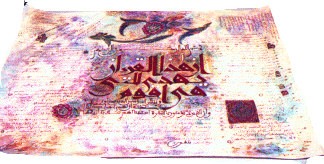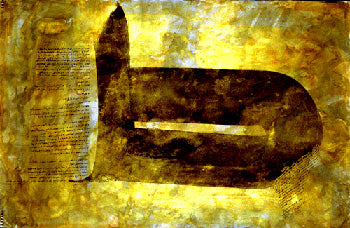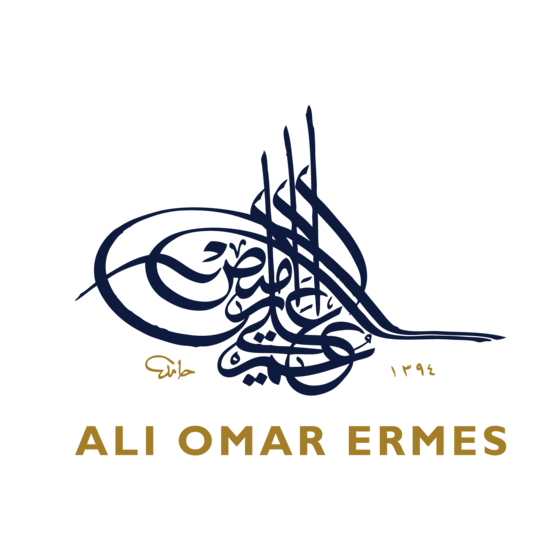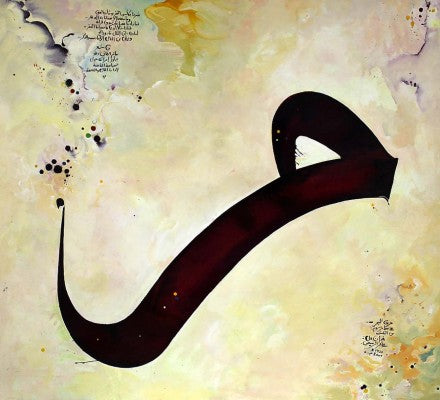Beit Al Qur’an - Religion, Art, Scholarship

Written by Ni'Mah Isma'il Nawwab
Photographed by Hussain A. Al-Ramadan
Its lustrous natural pearls, important archeo-logical sites and intricate handicrafts have long attracted visitors from around the world to Bahrain. But this small island in the Arabian Gulf is also the home of Beit Al Qur'an—the House of the Qur'an—a world-class museum of rare manuscripts of Islam's holy book and of other Islamic artifacts.
The museum was founded by Dr. Abdul Latif Jassim Kanoo, a member of a Bahraini merchant family whose written history goes back more than a century. But part of the money to build it also came from donations collected in a public fund drive, the first attempted in an Arabian Gulf country. It was "an undertaking fraught with uncertainty," says Kanoo, but successful. Beit Al Qur'an carries out all the functions of a modern museum: presentation of permanent and visiting exhibitions, conservation and restoration of manuscripts, publication of books, research, and sponsorship of cultural activities, lectures and seminars.
It also has a group of "friends of the museum" with unique motivation. "People, young and old, feel that they have a stake in our institute through their personal funding, which helped start this venture," Kanoo says. "But what made it possible is the immense desire of all Muslims to serve the Holy Qur'an and its message." And since that message is universal, he adds, "we welcome international visitors of all faiths."
The core of the museum's holdings is Kanoo's own collection of Qur'anic manuscripts and other Islamic art, one that he began after years of studying public and museum collections during his trips and studies abroad. As his collection grew, he came to feel a strong sense of responsibility toward the rare manuscripts he had acquired. Moving beyond ownership to the concept of custodianship, he donated his collection to a foundation he established in 1990 to operate a first-of-its-kind institution dedicated to the service of the Qur'an and the preservation of historic manuscripts.
"The institute serves as a custodian of Islamic traditions for future generations," comments Kanoo. "Especially when taking into consideration the importance of the Qur'an not simply as a manuscript to be displayed at a museum but as a living document by which Muslims live their lives."
Situated in the business district of Manama, the capital of Bahrain, Beit Al Qur'an is modeled conceptually on the traditional madrasas, or religious schools, that were attached to mosques in the Islamic world. They provided fertile ground for those who sought to cultivate Islamic knowledge and, like them, this institute combines religion, culture and learning under one roof.
It is housed in a building that itself combines Islamic and modern elements. A massive but understated textured-concrete exterior, fronted with a frieze of Qur'anic verses, gives no hint of riches within. But inside, sunlight streams through a score of small stained-glass domes, bathing the closed central courtyard in light. Intricately carved mashrabiyyas, or latticed windows, and panels of tiny, colorful tiles decorate this three-story space, from which entrances lead visitors to the five parts of the building.
Many visitors begin with a visit to Mathaf al-Hayat, the Museum of Life, whose ten rooms on two floors, interconnected by ramps and half-height walls, take up the largest part of the Beit Al Qur'an's space and contain some of the art treasures collected by Kanoo: armor, ceramics, glass, textiles, scientific instruments, manuscripts, clothing and ornaments from different periods and from countries as diverse as China, Tunisia, Morocco, Iran and India.
Some of the splendid examples of ceramics date from as far back as the ninth century; many come from such traditional centers of Islamic craftsmanship as Bukhara, Raqqah, Tehran and Iznik in today's Uzbekistan, Iraq, Iran and Turkey. There is a handsome 12th-century Persian jug made in Kashan and decorated with bold underglaze black and cobalt-blue motifs applied on a cream background, with bands of calligraphy around the middle and on the lip. Spectacular glass objects illustrate glassmaking techniques of various Islamic eras, including drawing, cutting, tinting, coloring and enameling.
Among the metal objects are a ceremonial Moghul damascened steel helmet decorated with arabesque designs, made in the 18th century, and a beautiful 23-centimeter (9") brass celestial globe decorated with bosses that represent stars and with images of humans and animals representing zodiacal signs. Objects from Safavid Persia, Mamluk Syria, Ottoman Turkey and Moghul India typify the wide range of metalwork shown.
Manuscripts in this part of the collection include a Moghul copy of the Shahnamah, or Book of Kings, Persia's national epic, in which the 60,000 verses by the poet Mansur Abu Kasim Firdawsi are illustrated with 79 miniature paintings that include court and battle scenes. Nearby is a magnificently illustrated 258-page copy of the Diwan of the great 14th-century Persian poet Hafiz.
Then comes the heart of Beit Al Qur'an: the collection of more than 5000 partial and complete Qur'anic manuscripts, displayed in specially designed cabinets with the sophisticated environmental controls and fiber-optic lighting essential for the proper display of rare and delicate old manuscripts. Within this setting, each piece can be viewed from various angles, and is displayed to highlight its prominent characteristics.
"Some of the manuscripts are unique masterpieces that relate to specific instances of Islamic history or to key developments in the art of Qur'anic calligraphy, illumination and printing," says Samar Al-Gailani, the museum director. "The collection is important on a worldwide scale, for rarely in modern times has such a range and variety of Qur'anic manuscripts and printings been assembled and made available to scholars and the public to study and appreciate." The collection contains manuscripts spanning all of Islamic history, and was gathered from locales as near as Makkah and as far as China.
In addition to the historical and spiritual value of the collection, the beautiful examples of Arabic script provide insight into the history and development of the language in its written form. The Qur'an was revealed to the Prophet Muhammad in Arabic, in the classical dialect spoken by the Quraysh, his tribe, which was preeminent in sixth-century western Arabia. The revelation eventually made Arabic the lingua franca of many nations, the sacred language of one-sixth of humankind, and the language of most Muslim scholarship.
Moreover, the Qur'an both drove the development of Arabic script and preserved it, for the rise and evolution of Arabic writing in its varied forms went hand in hand with the spread of Islam. New responsibilities and demands on the language accelerated the development of Arabic scripts and calligraphy, which were first called upon to meet the urgent need to record the Qur'an accurately as it had been revealed, then of coping with the administration of what rapidly became a vast multinational, multilingual empire.
To this day the survival and evolution of written Arabic is a source of wonder to scholars, particularly when viewed in light of the purely oral traditions of the early peninsular Arabs. The pre-Islamic people of Arabia, despite their passionate love affair with their language and their particular fondness for poetry, had disdained the written word, and relied mostly on the memories of members of their tribes to pass on to succeeding generations their renowned oral traditions.
But the Qur'an had to be recorded for posterity in a clear and tangible form that left no margin for doubt, amendment or error: It had to be written. And the desire to write it in a form worthy of its sacred message established the art of Arabic calligraphy—and the arts of the book in general—as enduring legacies of Islamic civilization. The Beit Al Qur'an collection attests to the development of Arabic scripts, the emergence of an annotation system to distinguish similar letters and indicate short vowels, the use of various writing materials and the rise of the art of manuscript illumination to unprecedented heights.
The collection includes some of the earliest Qur'anic manuscripts in the world, from Madinah, Iraq, North Africa and Spain. All of these are written in the stiff and angular kufic script, named after the Iraqi town of Kufa, where it was first formalized and popularized. (It was also used earlier in several variant forms in Makkah and Madinah.) It is appropriate for this script to be associated with Kufa, the stronghold of the fourth caliph, 'Ali, because he was a master calligrapher in his own right and among the first to transcribe the holy book.
These early Qur'an manuscripts are devoid of decoration and, like the script they are written in, are simple and austere, reflecting the harsh moral and physical environment in which they were created. Frugality is evident, too, in the use of space and material—understandably, in view of the dearth of media on which the Qur'an could be recorded. The earliest recording of parts of the Qur'an was done on such materials as leather, palm fronds, flat pieces of stone or bone, and wood. When parchment came into use, the skins of a large number of animals were required to complete one Qur'an, which was thus as expensive a process as it was laborious. As a result, the early Qur'ans are simple manuscripts, though many of them are extremely beautiful. An example is a parchment piece from the Hijaz, written in the seventh or eighth century in dark brown early kufic script, that is considered one of the oldest surviving Qur'anic manuscripts.
As the kufic script evolved, it developed a rationalized system of dots, strokes and sub- and superscript vowels, visible in eighth-and ninth-century manuscripts from Yemen, Spain, and North Africa, as well as Iraq and Iran—and indeed in all written and printed Qur'ans today. The annotation played a vital role in making the texts easy to read, but it also introduced a new dynamism to the esthetics of the Arabic script. A prime example at Beit Al Qur'an is a 10th-century parchment from North Africa that shows not only diacritical and vocalization marks but also a triangular arrangement of six gold dots that indicates the end of a verse, a convention which spread through much of the Islamic world.
By the end of the seventh century, with the growth of available resources, decorative elements began to appear in Qur'an manuscripts, initially consisting of simple colored rules at the beginning of each sura, or chapter, with the name of the chapter occupying a whole line. Later, by the end of the Umayyad period (661-750), these elements became more elaborate in composition and use of color. Earth tones and greens appeared, representing vegetal and architectural forms, as embellishments for chapter title designs. In fact, the colors help experts date manuscripts: Red and green, for example, were used during the eighth century. The colored inks were derived from vegetable sources, such as henna, coffee, flower petals or saffron; from different types of earth or sand; from precious or semiprecious stones such as turquoise and lapis lazuli; and from silver and gold. One item that exemplifies the use of ma' al-dhahab, or "gold water," is the pride of the Kanoo collection. Rendered on beautifully wrought deep-blue parchment and written in gold in Kairouan, in Tunisia, this rare piece of Islamic calligraphy—a page from Sura 29 of the Qur'an—is said to have been commissioned by the Abbasid caliph al-Ma'mun for the tomb of his legendary father, Harun al-Rashid. It is indeed a special piece, as no more than three or four Qur'an manuscripts are known to have been written on colored vellum.
By the end of the 11th century, manuscripts began to include elaborate designs in complex cursive scripts executed against highly decorative backgrounds of foliated arabesque scrolls in gold and color. The palette for these designs is predominantly blue. Regional preferences for specific colors also appeared, such as the gold, reds and greens used in North Africa and Andalusia. These decorative motifs developed, particularly under the Mamluks and Timurids (1370-1506), into a highly complex art. A copy of the Qur'an dated 1425 illustrates the intricately designed chapter headings and the colors that were typical of the Mamluk period.
The decorative traditions and styles used for the opening spread of the Qur'an— Surat al-Fatiha and the first page of the second chapter, Surat al-Baqara—were further developed and perfected under the Safavid (1501-1732) and later the Qajar (1779-1924) dynasties in Iran, as well as in Ottoman Turkey, particularly during the 19th century. The page frames assumed elaborate patterns of arabesque, floral and geometric motifs in a variety of bright colors and gold. The last three very short chapters of the holy book were also often decorated and set in highly colored and gilt frames, occasionally in combination with a decorated colophon. The colophon gave the date the manuscript was completed and the place where it had been written, and ended with a personal prayer specific to the successful completion of the reading of the entire Qur'an (du'a khatm al-Qur'an). Sometimes the name of the calligrapher also appeared, though invariably in extremely humble and self-effacing terms, and he usually asked God's forgiveness for transgressions and sought His blessing first for his parents and teachers, only then for himself.
Beit Al Qur'an also houses manuscripts that are unusual in their origin, their materials, or their shape or size. One, produced for the Safavid shah Husayn I, is written on veneer-thin slices of sandalwood; another is a prime example of 11th century calligraphy on paper from Iran. It is penned in a highly developed kufic style and uses white lettering surrounded with gold tendrils for the chapter heading; bold gold strokes, outlined in red, spell out the name of God. Yet another is an octagonal Qur'an manuscript measuring only 43 millimeters (1%") across. Such tiny but complete pocket copies of the Qur'an were prized by travelers, and a special script style, called ghubari, meaning "minuscule" or "miniature," evolved for use in their production. Their size posed a formidable challenge to scribes, for writing the Book in ghubari was an even more exacting labor of love than writing a full-size version. But since penning the Qur'an was itself an act of worship, many a scribe bore this burden happily.
Qur'ans at the other end of the size spectrum include a 50 by 70 centimeter (20 x 27") Moghul Qur'an in Indian script with an interlinear translation in Persian, each chapter rendered on a different color of paper. Such extra-large manuscripts, often commissioned for mosques, took much time—and fabulous large-muscle control—to complete. The most elaborate of them, reportedly from the Mamluk period (1250-1517), measured 75 by 50 centimeters (30 x 20"). Some were 350-page single volumes, others were produced in 30 volumes, each containing one juz', a standard 30th part of the Qur'an.
The Qur'an translations in the collection shed light on an interesting aspect of Islam. In many areas of the Muslim world where Arabic is not the first language, the Qur'an is either written or printed in an interlinear version, with the local language between the lines of Arabic to assist the reader in locating and comprehending the verses. Muslims— scholars and laymen alike—believe that attempts at translation and interpretation of the Qur'an fail to convey the full meaning, power and beauty of the holy book, because of the extraordinarily concise and allusive nature of the Arabic in which it was revealed. Indeed, even the word translation is somewhat suspect, and existing translations of the Qur'an into various languages are traditionally regarded as only interpretations of its meaning, and imperfect ones at that. Since understanding the Qur'an is a matter of faith and reading it a spiritual act, Muslims, no matter what their native tongue, learn Arabic to recite the original, untranslatable Word of God in their prayers and other devotions.
Beit Al Qur'an also helps explain the importance of calligraphy in the Islamic world, where Arabic script has long been the principal mode of artistic expression. While manuscripts were the primary form of this art, a remarkable variety of objects was adorned with lettering: Marble facades, doors, arches, plates, lanterns, tiles, rings, banners, axes and almost any other object of art or utility might be so decorated. But though Arabic calligraphy is a product of human skill and ingenuity and is widely used in everyday life, its origins have always been closely entwined with the sacred, because writing is the form in which the last divine revelation to humankind was recorded.
Because writing the Book was a pious act, the numen of the Qur'an extended to calligraphy. Besides professional scribes, many famous judges, political figures and ordinary devout Muslims enjoyed and practiced the art form, and more than 24 caliphs and sultans, from the Abbasid to the Ottoman period, had the honor of penning Qur'anic manuscripts. One of the most talented of these royal calligraphers was said to be the Ottoman sultan 'Abd al-Majid r. There were also several prominent women known for their beautiful script, including the Prophet Muhammad's wife Hafsah. Among the female scribes who produced Qur'anic manuscripts were Fatimah al-Baghdadiyah, who died in 691; Badshah Khatun, who wrote several Qur'an manuscripts around 1296; and Durrah Hanim, whose work dates to 1759.
The output of some professional scribes is astonishing. While some produced three manuscripts of the Qur'an in the course of their careers, others contributed up to a thousand. One 14th-century scribe recorded in a colophon that the present manuscript was his 69th, and that he hoped, God willing, to pen 100 or more before his death.
Calligraphy has also gained favor as a medium for modern artistic expression, particularly for religious texts. Present-day artists in the Arab and Islamic worlds are producing lively and interesting calligraphic compositions using Qur'anic verses or phrases. Several such modern pieces are showcased in the Beit Al Qur'an, done by world-famous calligraphers from countries such as Lebanon, Egypt, Indonesia, Pakistan and the United States. The work of American Mohamed Zakariya (see Aramco World, January/February 1992) is displayed next to that of renowned Egyptian calligrapher Ahmad Mustafa, who contributed a stained-glass work in the shape of a fish, formed of appropriate verses that refer to the bounty of the sea. Works by Lebanese calligrapher Wajeeh Nahlah and Bahrainis Rashid al-Uraifi and Abd Allah al-Muharraqi attest to the prominent role calligraphy continues to play in modern times.
After a tour of Beit Al Qur'an, many visitors head for one of its most tranquil areas: the mosque. Daily prayers are held within its premises, which accommodate up to 150 worshipers. A specially commissioned stained glass dome 16 meters (52 1/2') in diameter—one of the largest of its type in the world—covers an eye-catching circular prayer area. The dome, adorned with geometric patterns, features Verse 18 of Surat al-Tawbah ("Repentance"), also in the hand of Ahmad Mustafa.
The mosque's niche, or mihrab, which indicates the direction of Makkah and before which the imam leads prayer, is adorned with blue ceramic tiles designed and produced by Turkish craftsmen. Around its perimeter is written the famous Qur'anic Throne Verse, which movingly describes the power and glory of God. The mosque is a hub of activity, particularly during Ramadan, when every night tarawih, supplementary prayers, are held after the regular evening salah. The tarawih are followed by readings from the Qur'an by readers from across the Arab and Islamic worlds.
The House of the Qur'an is an unforgettable place, unique in its combination of fascination, appeal and instructive power. As Margaret Thatcher, former British prime minister, wrote in its guest book: "I have learned even more on this second visit. The treasures are exquisite and tell us so much about the past that we need to know. I shall hope to come a third time."
Ni'mah Isma'il Nawwab contributes articles on Arabian and Islamic history, customs and traditional arts to Aramco World and other publications from Dhahran, Saudi Arabia.
Hussain A. Al-Ramadan is a photographer in the Media Production Division of Saudi Aramco.
Verbatim
Written by Ni'Mah Isma'il Nawwab
The Qur'an, Islam's holy book, is the essence of Islam. It shapes all aspects of the daily life—both spiritual and temporal—of the world's billion-plus Muslims. For more than 1400 years it has been the single most important force binding Muslims to a system of belief and law which inspires them by its principles of social justice, honest living, human dignity, and individual responsibility.
Muslims believe the Qur'an to be God's message—His final revelation and the culmination of all earlier divine messages—transmitted to the Prophet Muhammad through the Archangel Gabriel. At its heart is monotheism, which is the foundation of Islam, and it summons its followers to believe in and honor all earlier prophets and to believe in all earlier divine scriptures.
The Prophet Muhammad received the divine revelation of the Qur'an over a span of some 23 years, one verse (aya) or several verses at a time, until his death in the year 632, by which time the Holy Book—114 sums or chapters in all—was complete. Believers in the emerging religion of Islam and the followers of the Prophet at first committed the Qur'anic text to memory and later, as he had instructed in his lifetime, wrote it down. The entire contents of the Qur'an therefore date back to the Prophet, and the placement of its verses and the arrangement of its chapters are according to his instructions.
It was realized soon after the Prophet's death that transmission of the written text of the Qur'an could not rely solely on the memories of the Prophet's Companions. The word of God Almighty had to be passed on with utter precision, in the form in which it had been revealed, without change or variation. The momentous task of collating and arranging the text into a single volume was eventually concluded in 651, under the orders of the third caliph, 'Uthman ibn 'Affan.
This collated volume was minutely checked by Companions of the Prophet and arranged according to his strict instructions. Later, four—some references say seven—identical copies were made. One of these master copies, or "Imams," was retained in Makkah while the others were sent to Iraq and Syria, where they, were kept in principal mosques to be used as references from which all subsequent volumes were to be reproduced and against which all copies would be checked. Thus, the Qur'an was recorded for posterity with exactitude, in a hard and tangible format, leaving no room for doubt, emendation, or error.
From that period to this day, as the copies on display in Beit Al Qur'an testify, fidelity to those volumes of the Qur'anic text has been so strict and so complete that no textual variants exist, nor can any copy be made, anywhere in Muslim world, except in full and absolute conformity with those authenticated copies.
This article appeared on pages 24-31 of the May/June 2000 print edition of Saudi Aramco World.
Leave a comment
Also in ART & CULTURE

2e Édition De Fikra “la Créativité Est Le Pilier De L’entrepreneuriat”
Vincenzo Nesci, l’un des principaux promoteurs de la 2e édition Fikra, lors de cette conférence internationale a abordé «la création d’entreprise et l’entrepreneuriat». Selon le directeur exécutif de Djezzy, ces derniers, «doivent être réalisés dans des conditions d’optimisme et de créativité pour permettre un réel essor dans les domaines commercial, industriel et créatif»



